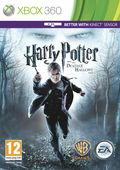You can trust VideoGamer. Our team of gaming experts spend hours testing and reviewing the latest games, to ensure you're reading the most comprehensive guide possible. Rest assured, all imagery and advice is unique and original. Check out how we test and review games here
From a development point of view, Harry Potter and the Deathly Hallows Part 1 is the story of trying to cater to at least two entirely different groups simultaneously. While officially it’s been built for pre-teen boys and is pegged as a kind of introductory shooter, it’s also been developed as a bit of an evolution for the series. It takes its cues from the book and movie; Hogwarts has been replaced with a moss-and-concrete English setting, Harry is on the run from the Ministry of Magic, and the guy is sporting some hefty “childhood-be-gone” stubble. Stuck somewhere between childhood and adulthood he’s actually surprisingly representative of the game which seems to have been built to bridge that awkward and often frustrating gap between young and old, casual and hardcore gamer.
The problem, however, stems back to the book. The novels had grabbed the attention of a full spectrum of readers. I remember the days when I’d spend at least ten minutes of my bus journey trying to count how many business women were working through a copy of Potter. It had universal appeal despite the fact that it was first and foremost a children’s novel.
Now the kids who treated the series like it was Beatlemania have grown up and probably become acquainted with console gaming along the way. But for the rest of the leftover Potter fans, it’s unlikely they’ve been swallowed up by gaming culture in the same way. The new generation are unlikely to have learned the traditional controls of shooters. So Deathly Hallows Part 1 attempts to set up the building blocks of the genre instead, taking what was a basic kids’ game and transplanting it to a mature genre – then distilling that genre to be accessible to kids and casual players.
In the level I was shown Harry is on his own at the centre of the building of Ministry of Magic, in what is basically a faceless grey maze of corridors which are patrolled by various enemies. So immediately you’re faced with two ways of dealing with the level: you can fight your way through it or pull on your invisibility cloak to stealth your way through the level.
The cloak system looks to be one of the more polished aspects at this stage, partly because it’s nice to see a traditional gaming conceit like stealth being so well integrated with such a recognisable technology from the novels. So in standard stealth style the faster you move, the closer you get to people, the more noise you make, the more you burn through your ability to stay hidden – stand still and it will regenerate. Get close enough to the enemy and you can stun them.
The gaming conceits continue through to spell-based combat, but the cache of spells at your disposal can feel less essential to the game than they really should do. Cast Confringo and you can concuss an opponent, cast Confundo and the enemy will temporarily be put on your side, cast Expelliarmus and you disarm whoever you have targeted. But generally speaking you could get through the game using Stupefy, the basic shooting-spell you have when you start the game.
It’s something made more apparent in Deathly Hallow’s Kinect adaptation, which functions as a very simple on-rails shooter. Raise your right arm to Stupefy, raise your left arm to shoulder-height and your right arm in the air for Confringo, or roll your arm forward to throw an exploding potion, but really just swinging about your right arm as quickly as possible does the trick, and occasionally Kinect seemed to interpret your arm-swinging as an attempt to cast a Stupefy spell regardless of what you were casting to begin with.
On Xbox it does at least try to encourage you to use new spells with a gaming-made-easy action wheel that you can bring up which pauses the game and allows you to select from your spells. Bosses, we’re told, are easier to defeat if you’re hammering away at them with something with a little more power than Stupefy can offer. Against Delores Umbrage it was recommended to try out Expulso to interrupt her spells and take her down faster. Similarly some can give you a defensive edge when you’re up against mobs of baddies. Levioso can be cast as either a defensive or offensive spell, giving you the ability to levitate objects to use for cover or to throw at enemies. Or you could try out Luck, another ability adapted from the novel for Potter fans, and cause enemies to lose accuracy when they blast you with their wands.
But then you’re met with game elements that are far too simplified even for the baffled video game n00b. Drinking potions involves pressing A when the game recognises you can use one, and recommends the most relevant potion in your inventory. Even targeting is done for you, often to your detriment. Head shots garner you more XP than body shots, yet you can’t actually aim up to the enemy’s head if you’re already targeting his body. It’s something they hope to fix before release if possible but if not means your ability to gain as much XP per level is severely limited.
Even so this already looks like the most interesting game in the series, offering a completely different tone to any of the previous titles. It’s just a matter of seeing if EA trust the gamer enough to let go of their hand.
Harry Potter and the Deathly Hallows Part 1 is due for release on on Kinect for Xbox 360, PlayStation 3, Wii, Nintendo DS and PC.
Harry Potter and the Deathly Hallows – Part 1 the videogame
- Platform(s): Nintendo DS, PC, PlayStation 3, Wii, Xbox 360
- Genre(s): Action

/https://oimg.videogamer.com/images/c374/harry_potter_and_the_deathly_hallows_a_part_1_5.jpg)






